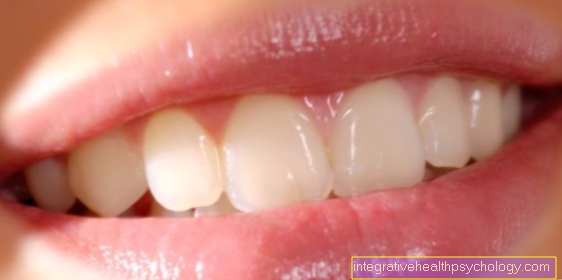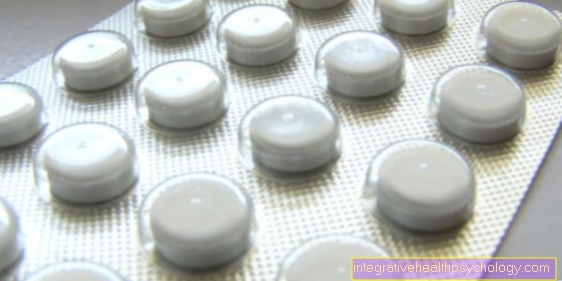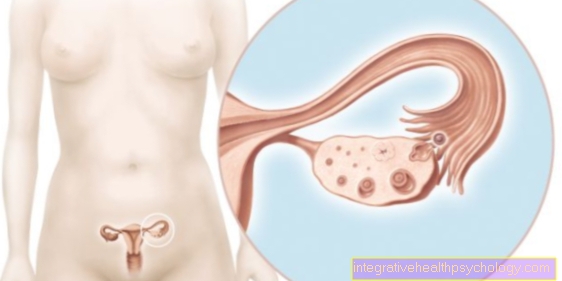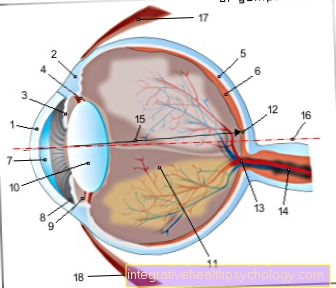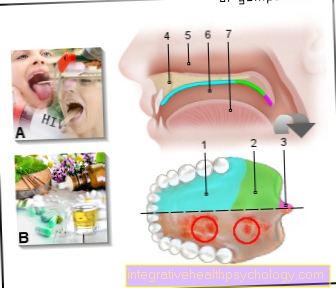Foreign matter in the eye
General
Foreign body injuries (foreign bodies in the eye) are relatively common in ophthalmology.
The patient usually complains of a sudden foreign body sensation with simultaneous strong tear formation. In many cases, the patient can remember the situation and may be able to tell the doctor what and how a foreign object got into their eye.

Initial measures for a foreign body in the eye
Dust, small soot particles or flies are usually rubbed out by the patient themselves or washed out by the onset of tears. The decisive factor here is whether the cornea was injured when the foreign body hit.
Even small scratches can cause severe discomfort and require an ophthalmological examination. The danger of superficial damage to the cornea is that at the point where the cornea is microscopically raised, friction is generated and can thus damage other areas of the cornea.
In the case of very severe corneal defects, there may even be a need for an operative corneal transplant. To prevent this, patients should first try to rinse their eyes.
If possible, the foreign body should be flushed out with an eye wash bottle. If none are available, the eye should be placed under a source of water and rinsed without rubbing. If there are already small cracks or scratches in the cornea, the symptoms will most likely not go away even after the rinse.
How can you rinse a foreign body from the eye?
Most foreign objects can be washed out of the eye with water. Before trying to rinse the foreign body out of the eye, one should wash one's hands so that no other foreign bodies get into the eye. The eye should be rinsed from the outside in, i.e. towards the nose, with running, clean water.
It is important that sharp-edged or pointed foreign bodies (e.g. glass or metal splinters) are not removed yourself. Even foreign objects that are stuck should not be removed yourself. In this case you should cover the eye with a sterile cloth and consult a doctor as soon as possible to avoid injuries.
What do I do if I can't get the foreign body out?
A foreign body in the eye should not be tried by any means to avoid injuring the eye. It is also advisable not to rub the eye.
If you have tried carefully to remove the foreign body or to rinse it out of the eye without success, you should cover the eye with a sterile cloth and quickly consult a doctor who will examine the eye for injuries and remove the foreign body.
When should I see an ophthalmologist?
An ophthalmologist should be consulted if pointed or sharp-edged foreign bodies have entered the eye. Here you shouldn't try to remove them yourself so as not to injure the eye. Until you get to the doctor, you should cover the eye with a sterile cloth.
A doctor should also be consulted if a foreign body sensation exists in the eye after a foreign body has been removed in order to rule out injuries, for example to the cornea.
In addition, a doctor should be consulted if it is not possible to remove the foreign body yourself.
Foreign body under the upper eyelid
If foreign bodies get into the eye, they can get under the upper eyelid as well as under the lower eyelid.
A foreign body under the upper eyelid can be tried to remove by lifting the upper eyelid slightly at the eyelashes. For example, you can try to remove the foreign body with a clean cloth or rinse it with water.
Here, too, it is important not to remove stuck or sharp foreign bodies yourself, but to consult a doctor as soon as possible and cover the eye with sterile covers.
Foreign body under the lower eyelid
Foreign bodies can get under both the lower and upper eyelids of the eye. If a foreign body gets under the lower eyelid, you can try to pull the lower eyelid down slightly and remove the foreign body with a clean cloth from the outside to the inside. It is important not to rub in order not to injure the eye. Alternatively, the eye can be rinsed from the outside in with clean water to remove the foreign body.
If the foreign body is pointed or sharp-edged or if it is stuck, one should not try to remove it and consult a doctor immediately. Until then, the eye should be covered with a sterile cloth.
Therapy Foreign body in the eye

In addition to numbing and fluorescent eye drops, the ophthalmologist puts a blue light into the eye.
This enables him to recognize the smallest scratches that light up yellow. Treatment is with eye ointment or eye drops containing antibiotics, which the patient must take for several days.
This is followed by a check-up by the ophthalmologist. If there is a foreign body in the eye, the ophthalmologist must ectropion the eye, i.e. he lets the patient look down and pulls the eyelid up, which gives him a better view of the eye (foreign body in the eye)
In the event of penetrations, i.e. injuries caused by sharp objects that fall into the eye or penetrate the eye and get stuck, the object must be left in place and an immediate emergency admission to the eye clinic must take place (foreign body in the eye).
The eye should not be examined manually and no ointments should be given.
If possible, a sterile bandage should be applied to the eye. Only in the eye clinic can the object be removed by surgery and the damage diagnosed.
If an object hits the eye and opens the eyeball, a sterile bandage must be put on and the eye clinic should close the wound as quickly as possible.
An open eyeball can e.g. recognize by a displaced iris (the iris is no longer round, but oval or warped). The danger of delayed wound closure is so-called endophthalmitis (an inflammatory reaction of the eye to infection). Injury from blunt objects can e.g. by expander purring in the eye or rubber bands as well as shooting bottle corks.
Here, too, an ophthalmological examination is urgently necessary (foreign body in the eye)
Eye drops for foreign bodies in the eye
Depending on what kind of foreign body has stuck in the eye or whether the eye has been injured by the foreign body, the doctor may consider it necessary to put an antibiotic ointment or drops in the eye for a few days to prevent infections.
Homeopathy for foreign bodies in the eye
A homeopathic treatment should always be discussed with the doctor in charge of a foreign body in the eye. For example, Arnica 30C can be taken as globules.
Accompanying symptoms of a foreign body in the eye
If there is a foreign body in the eye, accompanying symptoms such as pain, tearing, burning or reddening of the eye can occur. In addition, a foreign body can also make itself felt through sensitivity to light or blurred vision.
Red eyes
The irritation of a foreign body can inflame the eye and appear red. It is advisable to see a doctor to rule out injury or infection.
Eye pain
A foreign object can cause pain or an uncomfortable feeling in the eye. Pain in the eye can also indicate an injury, such as an injury to the cornea. It is advisable to consult a doctor who will look at the eye to rule out injuries and to give a therapy recommendation.
Watery eyes
When the eyes are irritated by a foreign body, they often start to water. The body tries to wash the foreign body out of the eye itself by blinking and tearing.
Injury to the cornea from a foreign body
If foreign bodies get into the eye, they can damage the cornea. Above all, pointed and sharp-edged foreign bodies, or foreign bodies that are stuck, can damage the cornea. A superficial corneal injury is known as corneal erosion.
A corneal injury is not necessarily visible, but can be noticed by a foreign body sensation, sensitivity to light or blurred vision. A corneal injury often heals on its own within two to three days without the formation of a scar.
If you suspect that your cornea has been damaged by a foreign body, you should consult an ophthalmologist to avoid possible complications.
You should note that contact lenses may only be worn again after the cornea has completely healed.
Foreign body sensation in the eye
A foreign body does not always have to be accompanied by a foreign body in the eye. A foreign body sensation can also be triggered by an inflammation in the eye, overstrained eyes, the onset of stye, or by external stimuli such as drafts or smoke. A foreign body that has already been removed can also leave a lasting foreign body feeling for a certain period of time. This can be the case, for example, if the cornea is slightly damaged.
It is advisable to visit an ophthalmologist in the event of an existing foreign body sensation in order to find the cause of the foreign body sensation and, if necessary, to initiate treatment.
Read more on the subject at: Foreign body sensation in the eye


